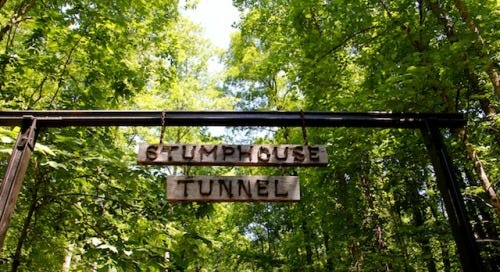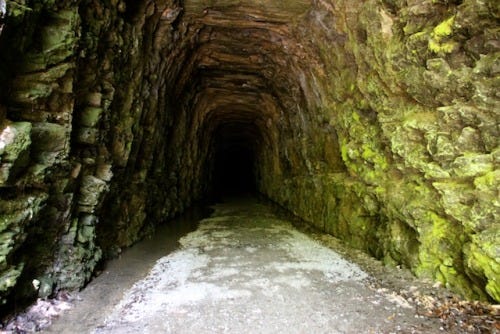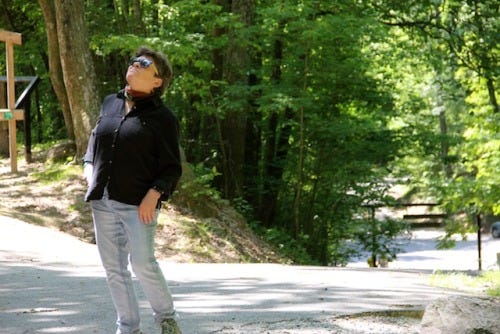As temperatures rise, an iceberg wedge salad can be quite appealing come suppertime. Now, after a recent pilgrimage to South Carolina, I have learned of a most worthy blue cheese for the topping. Please bear with this unexpected story.
The North Carolina mountains have long been a destination for Charlestonians and other South Carolinians seeking a reprieve from summer heat. The village of Highlands, where I spent the weekend, was among the most popular destinations. In the 1800s, however, getting to cooler climes from the coast required arduous journeys. Before the days of automobiles, the rail line north through the Upstate ended in Walhalla, South Carolina. From there, vacationers had to load up their luggage and hire horse drawn coaches. The jostling excursion up the mountain could take several days, depending on the depth of the Chattooga River at one of several crossings. The rugged switchbacks on rocky roads made for a dusty and dizzying ride.
Finally, in 1852, ambitious planners mapped out a path for the “Blue Ridge Railroad” that would connect Charleston to Knoxville, and ultimately, Cincinnati. Construction commenced from south to north the next year. The route would require 13 tunnels, the largest through Stumphouse Mountain, seven miles north of Walhalla.
Some 1,500 Irish people–miners and their family members–were brought to the mountain to tackle the deep blue granite with “hand drills, hammers, chisels, and black powder,” as a historical marker on the site explains. Aiming to create a tunnel more than a mile long and just wide and tall enough to permit a train to pass through, the miners first cut 16′ x 20′ air shafts to a vertical depth of as much as 200 feet into the mountain. Then they began excavating four horizontal tunnel sections, ultimately creating a 1,617 foot span underground. Legend has it that the immigrants also spawned a booming tavern business in their topside village called Tunnel Hill, where the workers would let off steam after their grueling shifts. The extremely hazardous duty paid less than two dollars per hour.
Blasting and drilling went on day and night. A million dollars into the project, South Carolina seceded from the Union, the Civil War began, the state’s economy collapsed, and the tunnel was never finished, though several efforts were made over the following decades to renew the project.
The ironically-named Mountain Rest, South Carolina, is now home to the “tunnel to nowhere” where a state park offers picnic and camping sites, a hiking trail to Issaqueena Falls (one of some 300 dazzling waterfalls in Oconee County), and a railroad museum.
Coming down Highway 28 from Highlands, Donna and I found the park, thanks to a friend who had mentioned its oddity. We found ourselves plummeting down a narrow corkscrew of a road from the park entrance through a lush canopy of hardwoods and flanked by blooming mountain laurel and ditch daisies. It was hard to imagine what the Irish folk must have thought of this rugged, almost-claustrophobic terrain when they arrived.
At road’s end, there is simply a parking lot and several narrative markers. Amid bird calls and an occasional swirling breeze, we walked up a steep, paved embankment about fifty yards. Ahead was the Stumphouse Tunnel, but well before we reached the opening in the rock, we were smacked in the face by a blast of cold air, as if someone had left the refrigerator door open. The chill hit like a wall of blue granite. The tunnel was dripping from above and leaching water down the sides. A sign had already warned visitors not to disturb the bats. I called out into the dimming light, and the echo was deep. I didn’t need to go any farther. The pulsing cold was delightful in the afternoon sun. We stood in awe of the long-ago labor.
But here’s the twist: In 1940, a Clemson College professor visited the abandoned tunnel and noted that the deep orifice maintained a steady humidity of 85 percent and a temperature of 56 degrees. This condition was a result of those vertical shafts the miners had created to enter the mountain’s rock from above. This climate, the professor suspected, would be perfect for curing cheese using the ancient method developed in the limestone caves above the village of Roquefort-sur-Soulzon, near Toulouse, in the south of France. Roquefort is one of the oldest known cheeses ever made and was favored by Charlemagne. The name is proprietary to France.
To make their own blue cheese, Clemson would not use French sheep’s milk, however, but chose Brown Swiss and Holstein cow’s milk. They developed mold strains perfect for the tunnel’s temperatures. Though milk shortages during World War II delayed the project, Clemson eventually bought the tunnel in 1951. They infused their local milk with mold cultures and transported it 30 miles to cure in the tunnel for six months at a time. From 1953 to 1956, the cheese was successfully manufactured, except during the summer months when conditions in the tunnel sometimes got a bit too warm. Eventually, Clemson’s food scientists replicated the tunnel’s conditions in their own air-conditioned ripening rooms in Newman Hall on campus.
Once again, the sad tunnel was abandoned until a coalition of conservation groups fought off a residential development plan and created instead a 40-acre conservancy that is now listed on the National Register of Historic Places and is managed as a park by the town of Walhalla.
Clemson is proud of its prize-winning blue cheese that’s distributed throughout the region. As they explain, “Each 288-gallon vat makes a batch of about 240 lbs, which is then salted, waxed and aged for 6 months. When it is ready, each hoop is scraped and packaged by hand. Each lot is kept separate, and strenuous record keeping assures quality at every step.” This venture is apparently not a money-making enterprise, but it is a rather distinctive marketing vehicle for the school. And it is delicious.
After reading about the tunnel’s short stint as a cheese cave, as modestly documented on the back side of one state historic marker, we immediately went to the nearest Ingle’s Grocery in Clayton, Georgia, and bought Clemson Blue Cheese in both crumbles and a wedge. Neither as harsh and stinky as a Gorgonzola nor as sharp and salty as Roquefort, Clemson Blue may well have been the first artisan cheese to come out of the South way back in the 1950s, and, like most everything from the region, it comes with a strange story attached. I prefer to think of it as Blue Granite cheese, in memory of the Irish miners.








